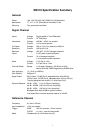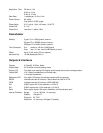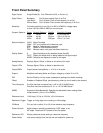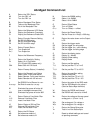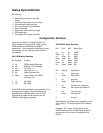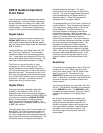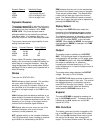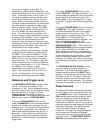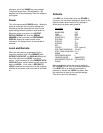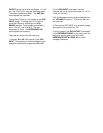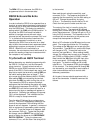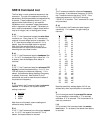10
currently displayed parameter. If the output is
greater than 1.024 times full scale, the REL
function will not be able to zero the output and the
ON LED will blink. The offset value will then be set
to its max value. If NOISE is being displayed when
the REL function is turned on, the noise ouptut will
require a sew seconds to settle again.
If the manual OFFSET in ON when the REL
function is turned on, the manual OFFSET will be
turned OFF before the auto zero is done.
The REL function and the manual OFFSET are
both ways to enter the offset value. When the REL
function is turned off using the REL key the offset
is turned off but the value is not lost. If the manual
OFFSET is now turned ON, the offset will be that
set by the REL function.
Offset
The OFFSET section controls the manual
OFFSET. The offset is turned ON and OFF using
the upper key in the OFFSET section. When the
offset is ON, the lower two keys are used to set
the amount of offset. A single key press will
advance the offset by 0.025% of full scale. If the
key is held down, the offset advances in larger and
larger increments, the largest increment being
10% of full scale. When the offset is turned OFF
the applied offset returns to zero but the offset
value is not lost. The next press of the upper
offset key (returns to ON) sets the offset to the
previously entered value.
If an attempt is made to advance the offset value
beyond full scale, the OFFSET ON LED will blink.
An offset up to 1.024 times the full scale sensitivity
may be entered. When the expand is on, this is
10X the full scale output.
If the REL function is ON when the manual
OFFSET is turned ON, the REL function is turned
OFF but the offset value remains the same. The
OFFSET keys may now be used to adjust this
offset value.
Note that the offsets (either manual offset or those
generated by the REL function) represent a
fraction of the full scale reading, and so their
absolute value will change when the sensitivity
scale is changed. A signal which has been nulled
by an offset will not be nulled when the sensitivity
scale is changed. The analog meter and the
output BNC indicate the same value given by the
equation:
V
out
= 10A
e
(A
v
V
i
cosØ+V
os
)
where...
A
e
= 1 or 10 per the Expand setting
A
v
= 1/Sensitivity
V
i
= magnitude of the signal
Ø = phase between signal & reference
V
os
= offset (fraction of FS < 1.024)
Time Constant
There are two post demodulator low pass filters,
labeled PRE and POST. The PRE filter precedes
the POST filter in the output amplifier. Each filter
provides 6 dB/oct attenuation.
The PRE filter time constant ranges from 1 mS to
100 S and is selected by the two keys below the
PRE filter indicator LED's. Holding down either
key will advance the time constant twice a second
in the desired direction.
The POST filter time constant can be set to 1 S or
0.1 S, or can be removed altogether, NONE, using
the two keys below the ENBW indicators. When
set to NONE, the total attenuation is that of the
PRE filter, or 6 dB/oct. When the POST filter is 1
S or 0.1S, the total attenuation is 12 dB/oct for
frequency components beyond the larger of the
POST and PRE filter bandwidths (reciprocal time
constant).
Noise
When the DISPLAY is set to NOISE, none of the
PRE and POST indicator LED's are on. Instead,
one of the two ENBW indicators will be on,
showing the Equivalent Noise Bandwidth of the
rms noise calculation. The ENBW is set using the
keys below the ENBW indicator LED's (same keys
as used to set the POST filter). The PRE filter
keys do nothing in this case. Pressing the upper
key when the bandwidth is already 1 Hz will reset
the rms noise average (output) to zero, restarting
the calculation. Likewise with pressing the lower
key when 10 Hz is already selected.
The noise is the rms deviation of the output within
a 1 or 10 Hz equivalent noise bandwidth about the
reference frequency. A dc output does not
contribute to the noise, the noise is determined




